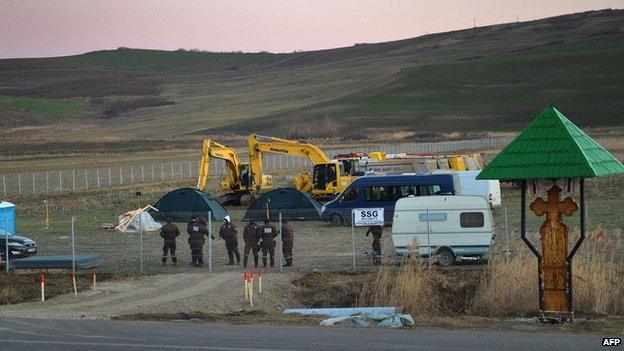Climate change and EU energy challenges
- Published
- comments

Germany has ambitious and expensive targets for renewable energy as nuclear is phased out
This week sees one of the EU's big announcements. On Wednesday it will set out its targets for cutting greenhouse gas emissions by 2030 and for increasing the use of renewables like solar panels and wind power.
It is a major moment because the EU has long regarded itself as the leader when it comes to addressing climate change. There are signs, however, that its early ambition may be hard to sustain.
These new proposals will replace the current 2020 strategy, external. By that date the target is to reduce greenhouse gas emissions by 20%, for renewables to make up 20% of energy use and for energy efficiency to increase by a similar amount. There are some signs of success. By the end of 2012 the EU had cut carbon dioxide (CO2) emissions by 18%. By 2020 that figure might have reached nearly 25%.
But before judging these latest proposals it is worth stepping back and noting some key developments of recent years that have changed calculations.
Europe under pressure
In late 2009 the EU saw the UN Copenhagen summit on climate change as a chance to occupy centre stage. The EU had suggested $150bn (£91bn; 111bn euros) was needed each year up to 2020 to help the developing world cope with climate change. But when it came to the big decisions the EU was bypassed.
A deal was done between the two big carbon emitters - the United States and China - with countries like India and Brazil looking on. It was a cautionary tale and as a consequence we hear less about the EU leading the world.
Secondly, the eurozone crisis: European real GDP per capita today is still below what it was in 2007. Europe is chasing elusive growth. That is its priority.
Thirdly, Angela Merkel's U-turn. After the Fukushima nuclear disaster in Japan in 2011 the German chancellor took an unusually swift decision: Germany moved away from nuclear power and bet its future on renewables.
Fourthly, energy costs. They are at least 25% lower in the United States, which has embraced fracking and the exploitation of shale gas. However concerned Europe is with climate change it also has to lower its energy costs and become more competitive.
So Europe in 2014 finds itself in a different place. Climate change arguably has become a more pressing challenge.

US energy giant Chevron is exploring for shale gas at Pungesti, in Romania
Moving targets
The UN Intergovernmental Panel on Climate Change says that, despite international efforts, emissions of CO2 and other greenhouse gases grew between 2000 and 2010. Even so, the question which will arise this week is this: is the Europe of today less ambitious, is it more constrained by current economic realities and less evangelical in its carbon-cutting zeal?
So to the targets for 2030. The European Parliament and others are pushing for a binding target of cutting CO2 emissions by 40%. It may end up lower. The EU Energy Commissioner, Guenther Oettinger, is proposing 35%.
Then there is renewable energy. Germany, having decided to close its nuclear reactors, is pushing strongly for a binding target of 30% by 2030. The higher the target the better it is for those German industries investing in renewable technology.
But some other countries like France and Britain are very reluctant to have their energy mix determined by Berlin. Both countries see nuclear power as a key element in cutting emissions.
So it may be that the target ends up lower than 30% and not enforceable by sanctions.
And this is where the economic reality bites. Subsidies for renewable energy are a factor in keeping energy prices high, which is not good for Europe's exporters.
Then there is energy efficiency. Some are pushing for a target of 40%. Even the current target is not legally enforceable and some, like the UK, argue that the only target that really matters is greenhouse gas reduction.
On the journey towards cleaner energy there are many differences, although the need to move forward is not disputed. Many meetings over many months lie ahead to determine what the ambition is for 2030.
And this week we will learn whether Europe is still determined to set the pace when it comes to climate change and whether Europe, desperate to be competitive, can drive down its energy costs.